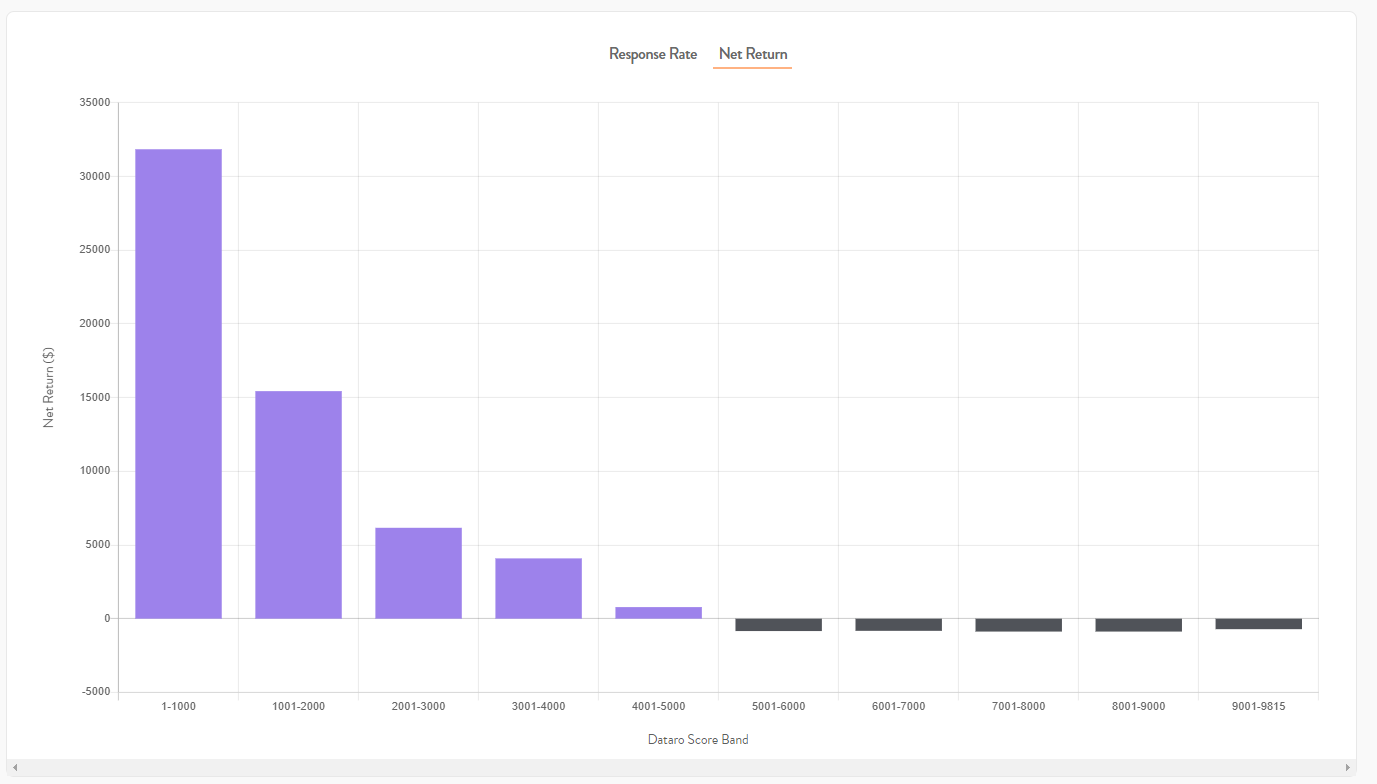Campaign size recommendations are intended to assist with building campaigns that achieve a high return on investment.
The short answers:
DM Appeal Campaign Size Suggestion
Dataro's mail appeal campaign size suggestions are calculated based on your donors' propensity scores, the estimated return per donor, and expected costs of your mail package.
Here's how it works:
- Propensity Score: The likelihood of the donor giving
- Estimated Return: Their estimated probable gift size
- Cost of Intervention: Estimated cost per piece of mail (or telemarketing call)
The formula is: expected_value = (probability * estimated_return) - cost_of_intervention
By calculating the expected value for every donor, we can estimate ahead of time at which point the ROI for contacting each donor will trend consistently negative. That is, at which point the cost of sending each letter exceeds the probable returns.
DM Appeal >$500 and 24M Lapsed Campaign Size Suggestions
These suggestions are simple heuristics or rules of thumb, based on Dataro’s experience working with Direct Mail teams across the globe.
- DM Appeal >$500 - this is calculated as 10% of the DM Appeal size suggestion. So if the DM Appeal suggestion is 8000, the DM Appeal >$500 suggestion will be 800.
- 24M Lapsed - this is calculated as 5% of the DM Appeal size suggestion. So if the DM Appeal suggestion is 8000, the 24M Lapsed suggestion will be 400.
The full answer
Return on Investment
There may be many motivations for a mass marketing effort including raising awareness of new issues and keeping donors engaged. However, the issue of maximising return on investment (ROI) is always central and it is an area where data and models can provide useful information on how to structure and deliver the campaign.
At Dataro, we have observed many campaigns that appear like the below example. If we chart the ranks of donors against the net return, there is a clear point where the campaign is consistently producing a negative ROI.

Predicting the point at which a campaign becomes unprofitable and focusing outreach efforts on donors most likely to generate a positive ROI would greatly benefit fundraisers before launching a campaign.
Dataro's answer to this question is the Campaign Suggestions feature.
Model Predictions
The prediction from a machine learning (ML) classification model takes the form of a probability value. In other words, Dataro's models are predicting how likely a donor is to perform a certain action. Whether we are predicting if a donor will soon give to an appeal or if they going to cancel their recurring giving commitment, the model's prediction takes the form of a score between 0 and 1. These are the same scores that you will see in your CRM and in the Dataro app. A score of 0 indicates that the model is 100% certain that the donor will NOT perform the action, while a score of 1 indicates that the model is 100% certain that the donor will perform the action.
In practice, almost all the scores are some value between 0 and 1, indicating that the model has some degree of uncertainty in its estimate. This can be useful for ordering the results, which can be useful for prioritising which donors to contact i.e. all things being equal, you should contact a donor with a lower rank. However, it does not provide a clear answer to which donors should be contacted as part of a mass marketing effort.
Expected Value
Taken at the level of the individual, ROI is about receiving more value from a donor than it costs to solicit the donation. While the costs of soliciting a donation can be known for many kinds of campaigns such as Direct Mail and Telemarketing, it is much more complicated to know ahead of time what value a donor will contribute. A donor may receive a letter and not donate, in which case we have incurred a negative ROI for that donor. Predictive models can help somewhat, as they can provide a good estimate of how likely a donor is to donate, however, consider the case where a donor has a high likelihood to donate, but then donates less than the cost of the letter. Again we have incurred a negative ROI.
We would like to know, ahead of time, which donors we should contact to be reasonably guaranteed of getting only a positive ROI. This approach will yield the highest possible net return on the entire campaign.
Dataro's method for doing this is to calculate the Expected Value for donors across each campaign type and suggest a total campaign size that should ensure a positive ROI for the campaign.
The expected value is calculated like so:
expected_value = (probability * estimated_return) - cost_of_intervention
Where:
- Probability: The model's estimate of how likely a donor is to perform the action.
- Estimated return: Is the monetary value of the donor performing the action. In the case of an Appeal, this is simple to estimate (i.e. using the Dataro Ask Amount). In other cases such as RG Churn, it is more complicated (estimate the revenue value of retaining this donor for a reasonable period of time).
- Cost of Intervention: The cost of soliciting a donor for this campaign type (based on the settings for Mail and Phone in the Dataro App)
By calculating the expected value for every donor, we can estimate ahead of time at which point the ROI for contacting each donor will trend consistently negative.
FAQS
Do campaign size suggestions fluctuate for seasonality?
Yes. Dataro's appeal campaign size suggestions do take seasonality into account as they are influenced by your donors' propensity scores. As more donors may be likely (or unlikely) to give at particular times of year, this will flow through into the size suggestions. For example, you might see larger size suggestions during traditionally strong giving periods (like Christmas) and smaller suggestions during historically slower periods.

